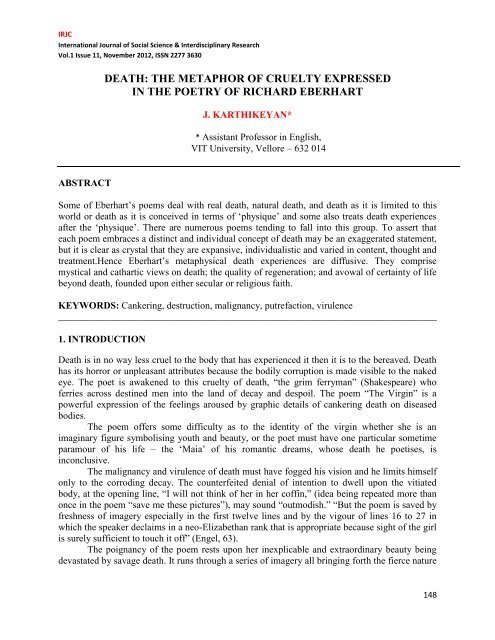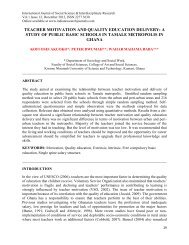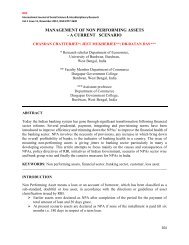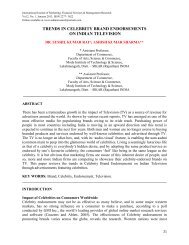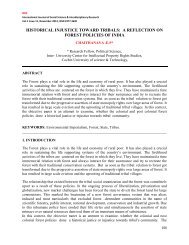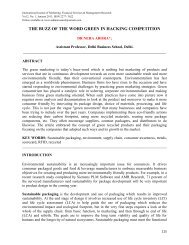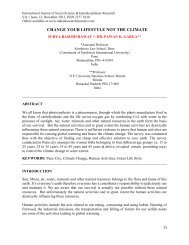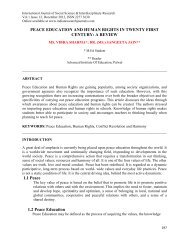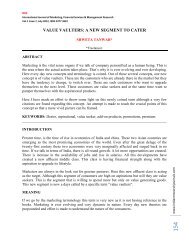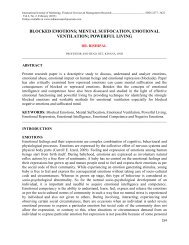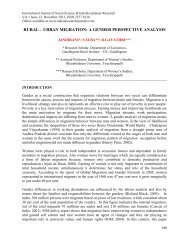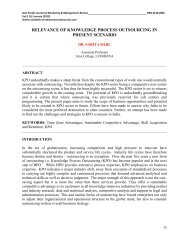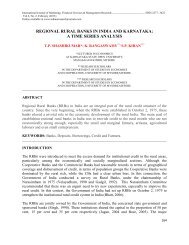death - indian research journals
death - indian research journals
death - indian research journals
You also want an ePaper? Increase the reach of your titles
YUMPU automatically turns print PDFs into web optimized ePapers that Google loves.
IRJC<br />
International Journal of Social Science & Interdisciplinary Research<br />
Vol.1 Issue 11, November 2012, ISSN 2277 3630<br />
ABSTRACT<br />
DEATH: THE METAPHOR OF CRUELTY EXPRESSED<br />
IN THE POETRY OF RICHARD EBERHART<br />
J. KARTHIKEYAN*<br />
* Assistant Professor in English,<br />
VIT University, Vellore – 632 014<br />
Some of Eberhart‟s poems deal with real <strong>death</strong>, natural <strong>death</strong>, and <strong>death</strong> as it is limited to this<br />
world or <strong>death</strong> as it is conceived in terms of „physique‟ and some also treats <strong>death</strong> experiences<br />
after the „physique‟. There are numerous poems tending to fall into this group. To assert that<br />
each poem embraces a distinct and individual concept of <strong>death</strong> may be an exaggerated statement,<br />
but it is clear as crystal that they are expansive, individualistic and varied in content, thought and<br />
treatment.Hence Eberhart‟s metaphysical <strong>death</strong> experiences are diffusive. They comprise<br />
mystical and cathartic views on <strong>death</strong>; the quality of regeneration; and avowal of certainty of life<br />
beyond <strong>death</strong>, founded upon either secular or religious faith.<br />
KEYWORDS: Cankering, destruction, malignancy, putrefaction, virulence<br />
______________________________________________________________________________<br />
1. INTRODUCTION<br />
Death is in no way less cruel to the body that has experienced it then it is to the bereaved. Death<br />
has its horror or unpleasant attributes because the bodily corruption is made visible to the naked<br />
eye. The poet is awakened to this cruelty of <strong>death</strong>, “the grim ferryman” (Shakespeare) who<br />
ferries across destined men into the land of decay and despoil. The poem “The Virgin” is a<br />
powerful expression of the feelings aroused by graphic details of cankering <strong>death</strong> on diseased<br />
bodies.<br />
The poem offers some difficulty as to the identity of the virgin whether she is an<br />
imaginary figure symbolising youth and beauty, or the poet must have one particular sometime<br />
paramour of his life – the „Maia‟ of his romantic dreams, whose <strong>death</strong> he poetises, is<br />
inconclusive.<br />
The malignancy and virulence of <strong>death</strong> must have fogged his vision and he limits himself<br />
only to the corroding decay. The counterfeited denial of intention to dwell upon the vitiated<br />
body, at the opening line, “I will not think of her in her coffin,” (idea being repeated more than<br />
once in the poem “save me these pictures”), may sound “outmodish.” “But the poem is saved by<br />
freshness of imagery especially in the first twelve lines and by the vigour of lines 16 to 27 in<br />
which the speaker declaims in a neo-Elizabethan rank that is appropriate because sight of the girl<br />
is surely sufficient to touch it off” (Engel, 63).<br />
The poignancy of the poem rests upon her inexplicable and extraordinary beauty being<br />
devastated by savage <strong>death</strong>. It runs through a series of imagery all bringing forth the fierce nature<br />
148
IRJC<br />
International Journal of Social Science & Interdisciplinary Research<br />
Vol.1 Issue 11, November 2012, ISSN 2277 3630<br />
of <strong>death</strong>. The worms are the agents of <strong>death</strong> in completing the destruction. All the three<br />
adjectives qualifying the cheek – „red‟, „white‟, „soft‟ – are suggestive of her admirable beauty.<br />
There is a shift in nature of personifications, the harsh <strong>death</strong>, the “needling” giant cruelly<br />
visualised stands in contrasts to naughty „boy winds‟ playfully fingering her „resilent hair‟. The<br />
first process of destruction of the flesh is complete by the graphic description:<br />
The virginal nipples pinched by stones<br />
The silver belly sullied by slime, ... (12)<br />
The use of alliteration adds to the intensity of destruction. The order of decay moves from<br />
the fleshy body to the solid, less vulnerable bones which formed the structure and the support of<br />
the body once but now bereft of the strength:<br />
.... bones, O!<br />
Without strength to round the womb.<br />
And April skin-shine browned and fouled. (16)<br />
The concept that whether the declension of the mind corresponds to the deterioration of<br />
the body is debatable. But to the imaginative writer like Eberhart, it is possible:<br />
Stinking under the sweating earth,<br />
The mind‟s whole marble disembowled. (20)<br />
Whether the poet refers to the retention of consciousness which he describes in “When<br />
Golden Flies upon my Carcase Came” or the remnants of the brain inside the skull are not clear.<br />
The poet makes a pathetic plea to the “Captain worms of the gross earth,” that he should blot out<br />
the picture of “formal decay” from his mind.<br />
The next four lines give a series of personifications of <strong>death</strong> – the „pornographic nature of<br />
<strong>death</strong>‟ – with all loathsome and repugnant association of obscenity. It is a strange one Eberhart<br />
attributes ever feminine quality to <strong>death</strong>:<br />
She is a beggar and<br />
Whore, or baser, a designing lecher ;<br />
Equal to Helen, diced with jewels,<br />
Putrid at the bawdy event, like her. (30)<br />
The familiar Helen of Troy – the Queen of beauty is the agent of destruction and <strong>death</strong> in<br />
its destructive nature is likened to her. Even in its formal decay there is a fascination and there is<br />
some subtle imperceptible beauty.<br />
The next few lines are about his poor Moll – the victim of <strong>death</strong> – who is “dead as a<br />
stump.” He is partly consoled that he did not know her in that pathetic plight:<br />
But in feeling‟s jammed proximity;<br />
Doltish memory, cranky perception (CP : 1985,189)<br />
he sees this “ruinous vision.” These feelings of nearness and affinity bind them together.<br />
The impact of the “ruinous vision” leaves his mind vigorously morbid.<br />
The destruction can be considered on three levels – the havoc on the body, on the bones<br />
and finally upon the mind, the realistic progressive deterioration under which the despoil has<br />
been masterly conducted by “Captain worms.” The moment of great intensity is cryptically<br />
drawn by the picturesque metaphors. The grief on the part of the speaker is made acute by the<br />
contrast between perfect beauty and an noxious condition to which it has been reduced. The<br />
grave is an end by itself and there is nothing beyond that.<br />
“When Golden Flies upon my Carcaso Came” is another vivid illustration of physical<br />
decay, an unsentimental treatment of his imagined <strong>death</strong>. On the superficial level, there is no<br />
149
IRJC<br />
International Journal of Social Science & Interdisciplinary Research<br />
Vol.1 Issue 11, November 2012, ISSN 2277 3630<br />
sense of horror, mystery, morbidity or anything dreadful, instead he objectively views and enjoys<br />
at their play, the mission of completing the bodily decay. He seems to have felt that even<br />
physical decay is not an horrible as one imagines it to be.<br />
The golden flies, “those pretty monsters,” “shining globules” like “tautened oily suns”<br />
assemble the luminous gems upon one point and bloom like “burning gold.” They work out a<br />
“disdem” decked with “their several gems.” In a sarcastic manner, he watches the devouring<br />
decay upon the “rotten flesh” brought about by the senseless little monsters, proclaiming the<br />
passing of time and the consequent arrival of <strong>death</strong> and decay. He exclaims that there is still<br />
beauty “even at the guts of things.” One might wonder whether it is possible to watch one‟s own<br />
decay, and is there anything surviving, soon after one‟s last breath.<br />
To associate flies with putrefaction and decay is quite common. Though the poet assumes<br />
a bold front, there are suggestions of inward fear and horror at bodily corruption and<br />
decomposition. He would have seemingly defied fear and dread, but frequent suggestions to the<br />
burning gold do not give pleasant and approving suggestions. The horror is inwardly experienced<br />
but he tries to conceal it. The flies are monsters and the poet is entrapped. This recalls to one‟s<br />
mind Dickinson‟s “I heard a fly buzz when I died.” The point of attraction for Eberhart is the<br />
sight, visual; whereas to Dickinson it is the sound, auditory.<br />
Toynbee remarked that <strong>death</strong> is a diadic event and the survivors‟ burden is greater. The<br />
“cruelty of reality” reflects more terribly on the survivors than on the deceased ones. The effects<br />
of <strong>death</strong> are apparently manifested more upon the survivors than on those who experience it.<br />
Eberhart has written quite a number of poems describing his mournful experience at the loss of<br />
some of the people whom he personally knew and frequently not.<br />
Even in dealing with real <strong>death</strong>, very rarely does Eberhart follow the epithaphic manner<br />
and elegiac pattern. His beautiful lyric “Lose” which belongs to his mid-poetic career, is from<br />
the “The Quarry collection”. During the course of Eberhart‟s conversation with Engel, he had<br />
expressed much admiration for one Viola Lang, an actress and writer of verse dramas.<br />
As a playwright, Eberhart must have known her personally and appreciated her extraordinary<br />
talents in acting. “Loss” has come out very well – a poem with an unsullied and<br />
touching expression of grief. This is dedicated to the same lady and a sincere homage is paid by<br />
a fellow artist.<br />
The first three stanzas are a realistic portrayal of the poet‟s honest impressions about her<br />
– the feelings which have the capacity to move the heart. There is a kind of magical spell which<br />
is cast upon the poem and there is a kind of elusive and mysterious fascination about her gentle<br />
personality. The enchantment is increased by the lucidity of expression and melodious phrasing.<br />
Verbal paraphrasing would be an utter failure and when attempted, full justice cannot be done :<br />
Her loss is as something beautiful in air,<br />
The mysterious part of personality<br />
Become the blue mystery of the air,<br />
The far and the near. (CP: 1960,200)<br />
As an artist and playwright, she probably had an artistic personality and turn of mind<br />
which, “Become the blue mystery of the air.” The colour blue suggests not only sunnier aspect<br />
but also an amount of clarity and unearthliness. It commutates mobility and grace too. As in<br />
Steven‟s “The man with the blue guitar,” it ay also stand for the colour of the transforming<br />
imagination and its products. As an actress, she infused gaiety, joy and laughter into her life.<br />
150
IRJC<br />
International Journal of Social Science & Interdisciplinary Research<br />
Vol.1 Issue 11, November 2012, ISSN 2277 3630<br />
“She made things gay and severe.” There is something austere about her personality. She<br />
must have successfully played many “roles” – may be directly referring to her part as an actress<br />
and indirectly hinting at the “roles” she must have played in the drama of life. The image “of<br />
dark and light” is skillfully adopted to single out the uniqueness of “her feminine grace of<br />
seeing” against the other “markings of dark and light.”<br />
The tone of philosophising fuses into the liquid simplicity of expression and in the<br />
concluding stanza the first two lines read as follows:<br />
I do not know how to say no<br />
To time that goes in any case, (13)<br />
These monosyllabic lines most powerfully and profoundly add to the sense of wonder the<br />
poem has successfully created. There is a note of disappointment, feeling of incompletion and<br />
failure of words to aid him for the appropriate portrayal of his sincere feelings over her less; and<br />
a sheer inability to explain his abandoned feeble condition at “The pure loss and the vision of her<br />
face.”<br />
The diction is extremely simple and the lines, short or long depend on the melodious<br />
phrasing. The weaving back and forth of the same words and the repetition of the line. “Far and<br />
the near” to conclude the first two stanzas, are the artistic devices carefully adopted, to give the<br />
poem a sense of swiftness and a poignancy.<br />
There is a non-stop easy flow of words. What David Daiches has remarked about the<br />
diction of Eberhart‟s collection of Poems, New and Selected can appropriately be cited here too.<br />
“Eberhart has succeeded in aerating his language, in breaking down something of its oversolidity,<br />
so that such line and stanza responds more delicately to the idea which prompted it”<br />
(David Daiches Towards the Proper Spirit 94).<br />
Corollary to the theme and treatment of “Loss,” is the simple poem “To Eyan.” It<br />
penetratingly manifests the helplessness of the bereaved towards the dying. Death is not beyond<br />
children‟s ken. “To Evan” describes the <strong>death</strong> of a small child. The boy is the first son of<br />
Eberharts wife‟s brother, his nephew. In what form and exactly at what age, the <strong>death</strong>-stroke had<br />
fallen upon him is not disclosed, hence of no importance to ponder upon mortality. But he must<br />
have suffered from sickness and <strong>death</strong> must have been a prolonged agony (“Dying slowly”).<br />
It is an impassioned but restrained cry that the angelic form has taken his deep sleep and<br />
the poet is not able to prevent it :<br />
I wanted to give him some gift,<br />
The breath of my breath, the look of my eyes,<br />
I wanted to give him some gift,<br />
Lying there so piteously. (16-20)<br />
The clever manipulation and the ringing repetition of the line “I wanted to give him some<br />
gift” – tellingly echoes the despair, helplessness and the poets‟ deep down desire to save the boy<br />
at any cost. The comprehends his sacrificial gift of his life, but to restore life in him, would be<br />
“unwise.” His outrageous cry against the sky “at the unequal fate held over us from our birth” –<br />
is a universal and futile cry against <strong>death</strong>, a cry “man has from the beginning.” Even the “weight<br />
of his experience” has failed the poet to get reconciled to the “king of horrors” (The Bible).<br />
The universal truth about man‟s limitation and his incapacity as not only to “suspend”<br />
<strong>death</strong> but also to apprehend the “secret from secrecy” is presented in the most affecting manner.<br />
The little one has made his exit into the world inspite of the poet‟s pitiable cry. The poet passes<br />
151
IRJC<br />
International Journal of Social Science & Interdisciplinary Research<br />
Vol.1 Issue 11, November 2012, ISSN 2277 3630<br />
“away silently and see(s) him no more.” The inequality of gorging <strong>death</strong> visiting upon “careless<br />
childhood” and a “slow consuming age” in “The Tobacconist of Eight Street” can be paralleled.<br />
The intense ferocity and sorrow at dire “Hell‟s grim tyrant” (Pope) is in no way mitigated<br />
when the <strong>death</strong> of a stranger, the tobacconist is, at consideration. The poet must have had secret<br />
admiration for the peevish old man at his business – mixing tobacco and pouring fragrance into<br />
it. With a keen observation, the poet has established the character and the singular personality of<br />
the businessman.<br />
The stern voice of the man is exemplified by the phrase “Fields of Fire / Or of Arabia<br />
were in his voice.” One can see, “The weights of age, of fear were in his eyes / and on his neck<br />
time‟s cutting edge.” One day when the poet happens to pass the Eighth street, the man has<br />
already “taken the downward path of life” (Horace). This particular incident becomes a wild<br />
lament on man‟s evanescence and mortality and how life hangs by a thread:<br />
And I howling into the crooked streets, Smashed with recognition; for<br />
him I flayed the air, for him cried out, and sent a useless prayer to the<br />
disjointed stones that were his only name: Such insight is one‟s own<br />
<strong>death</strong> rattling past. (Opp, 25)<br />
The sorrow overshadows him so much that he does not ponder upon beyond <strong>death</strong> and<br />
takes it for granted that <strong>death</strong> is absolute and it is an end by itself and leads nowhere. The<br />
considered poem describes the poet‟s depressed feelings at obituary of near and far whereas “The<br />
Lament of a New England Mother,” is an imaginary portrayal of the bereavement experienced by<br />
the woman at the loss of her husband.<br />
There are some poems of Eberhart which take the narrative form. The narrative form<br />
treats an imaginary event the “The Lament of a New England Mother.” The treatment of tender<br />
human emotion is presented in the most extraordinary way.<br />
The specific occasion of which the poem treats is being disclosed. A woman has been<br />
deprived by <strong>death</strong>, of a loved one-her husband. Presumably, she has lost her way in sorrow,<br />
despair and bereavement. Concentrated capsule like phrases are suggestively used to illustrate<br />
her heart-rending sorrow. In the castle of torment – “I swing in the winds of chance.” She is shut<br />
up in the well fortified castle from which there is no possible outlet.<br />
Her helplessness against fate is more intensified by the next analogy – how much she has<br />
been awayed “in the winds of chance,” implying that the course of the wind is unpredictable,<br />
hence fate unforeseen. The formidable fate is mighty and dominant like that of the potent wind.<br />
She gets struck and blown terribly and her whole outlook is altered. The world was most<br />
stable once, but now she sees it “rocking.” Her once staunch will is trembling and measures the<br />
“panic” of her state. She realizes that the series of her miseries are as a result of having affronted<br />
providence with spleen.<br />
But there is no sign of regret. Her fidelity to her husband is questionable when she cries,<br />
“When shall I trust in the love of pure husband?” She feels the impossibility of getting over her<br />
selfishness and hypocritical arguments. Her sincerity to her husband is at stake when she refers<br />
to so many of her lovers “gone into the garden.”<br />
Her vision of the world is a hostile one. The world crushes and humiliates man.<br />
Discarding the luxury and false sense of values, she yearns to “live in the rich simplicity of the<br />
earth.” She thinks of herself as “the lost cornucopia / of June” – the abundant source of rich<br />
supply which she once enjoyed.<br />
152
IRJC<br />
International Journal of Social Science & Interdisciplinary Research<br />
Vol.1 Issue 11, November 2012, ISSN 2277 3630<br />
Abruptly the tone changes from indignant pain to the thought of her husband whose grave<br />
yard is on the hill. The sight terrifies her with the “rancour” of life. All her lovers have entered<br />
the “garden” and now she is companionless. Her fertile imagination is the “pest” to the world<br />
and annoys the world so much. She gives a vivid description of her state “I am a checker work of<br />
secret” – “Knocking together in a burden of black action.” Life has wrung her. Her “Despair is<br />
noncapitulatory” that is it cannot be appeased.<br />
There is little in the poem to suggest why she seeks <strong>death</strong> except for the vulnerability to it<br />
and the fact of her solitude. The idea of <strong>death</strong> takes the same attraction – repulsion – dichotomy<br />
– towards life and world. The tension built upon the poem pivots upon her committing “myself<br />
into the hands of the State.”<br />
Death is no doubt a reality but it is the cruelty of all realities as the poet has conceived it,<br />
cruel to the lifeless bodies and even more cruel to the survivors.<br />
WORKS CITED<br />
Eberhart, Richard. Selected Poems. New York: Oxford University Press, 1951.<br />
---. Collected Poems 1930-1960. New York: Oxford University Press, 1960.<br />
---. Selected Poems 1930-1965. New York: New Directions, 1965.<br />
---. Poems. New and Selected. Norfolk, Connecticut: New Directions, 1945.<br />
---. “How I Write Poetry,” Howard Nemerov, ed. Contemporary American Poetry, New York:<br />
n.d.<br />
Engel, Bernard F. Richard Eberhart. New York: Twayne Publishers, 1971.<br />
Eberhart, Richard. Of Poetry and Poets. Chicago: University of Illinois Press, 1975.<br />
Mills, Ralph, J., Tr. Richard Eberhart. Minneapolis: University of Minnesota Press, 1964.<br />
153


